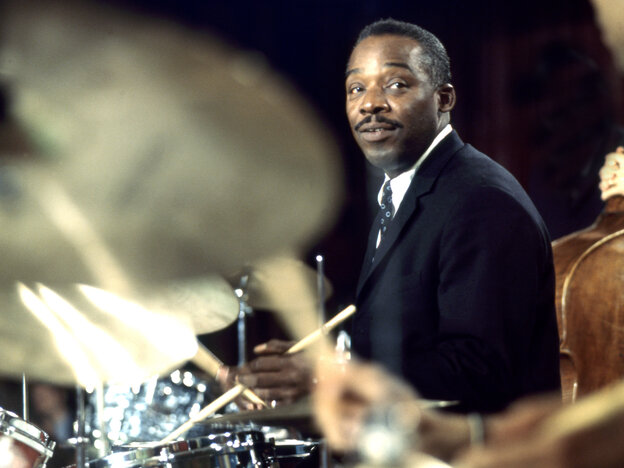The Drummer Who Invented Jazz’s Basic Beat
It doesn’t take an expert to identify this sound as a jazz rhythm:
Musicians call it “spang-a-lang,” for obvious phonetic reasons, and it’s so synonymous with jazz, it no longer occurs to us that someone had to invent it. But someone did: a drummer named Kenny Clarke, who would have turned 100 today.
Spang-a-lang was only part of Clarke’s innovation. Marking time on the ride cymbal with his right hand — previously, jazz drummers employed the bass drum with the right foot — gave his left hand and feet the freedom and sonic space to play thundering accents (“dropping bombs”) at irregular intervals. The sound they made inspired another phonetic term: “Klook,” which became Clarke’s nickname.
 “Clarke represents a tectonic shift,” drummer and educator Ralph Peterson says. “He is the patriarch of drumming in modern jazz.”
“Clarke represents a tectonic shift,” drummer and educator Ralph Peterson says. “He is the patriarch of drumming in modern jazz.”
Born in Pittsburgh in 1914, Clarke was a musical prodigy, drumming professionally with local big bands in his teens. By his 20s, he was working with Louis Armstrong and Roy Eldridge, superstars in their day.
This was the late ’30s: Jazz was still dance music, with the drums providing heavy beats for Lindy-hopping feet. Most drummers struck the bass on every beat in the measure, a technique known as four-on-the-floor. But as Clarke recalled to writer Ira Gitler in Swing to Bop, while playing with Teddy Hill’s big band one night in 1939, an arrangement of “Old Man River” went too fast for his foot to work the bass pedal. Instead, he kept the pulse going on the cymbal, using the bass and snare to “cut the time up.”
It was initially too weird for dancers and bandmates used to four-on-the-floor: Clarke was soon fired. But Teddy Hill remembered him in 1941, when recruiting the house band for a Harlem spot called Minton’s Playhouse. Minton’s became the laboratory for what would soon be called bebop or modern jazz — a less danceable, more abstract approach to the music — which was built substantially on Clarke’s rhythmic ideas. The classic tune “Epistrophy,” which Clarke wrote with pianist Thelonious Monk, is shaped like the bombs he dropped: an asymmetrical melody with accents placed irregularly, often just off the beat.
Clarke was drafted in 1943 and spent three years in the Army, thus personally missing out on bebop’s first public breakthrough. But its prime practitioners knew what he’d contributed, and when he was discharged, trumpeter and bebop pioneer Dizzy Gillespie installed Clarke in the rhythm section of his new big band. (That rhythm section later broke off and became the first incarnation of the Modern Jazz Quartet.)
As bebop gained predominance, Clarke became the most in-demand drummer on the scene — so much so that he began turning away work with major figures like Miles Davis. “Miles knocked on my door, so I told the little girl I was with to tell him I’m out,” Clarke told journalist Mike Zwerin. “I was tired, man.”
In 1956, he took a gig in Paris with pianist Michel Legrand. It was supposed to be a brief respite from New York; instead, Clarke stayed in Paris until his death in 1985. He was out of the American jazz limelight, but got to play music on his own terms. He played often with old friends from the U.S. who were passing through or similarly expatriated, and with the big band that he co-led throughout the 1960s with Belgian pianist Francy Boland.
Other drummers would refine his ideas, and often receive more credit as innovators. But it was Clarke who first established the rhythmic language that we recognize immediately as jazz today.
By Michael J. West
Originally published at NPR.org

